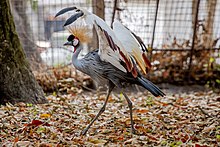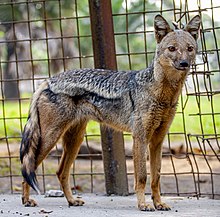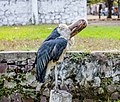| Kinshasa National Zoological Park | |
|---|---|
 Colorful African crowned crane in Kinshasa Zoological Garden Colorful African crowned crane in Kinshasa Zoological Garden | |
| Date opened | July 17, 1938; 86 years ago (1938-07-17) |
| Location | Gombe, Kinshasa, Democratic Republic of the Congo |
| No. of animals | 129 |
| No. of species | 30 |
| Owner | Congolese Institute for Nature Conservation |
| Director | Simon Dinganga Tra Ndeto |
| Website | https://zoodekinshasa.com/ |
The Kinshasa National Zoological Park (French: Parc Zoologique National de Kinshasa) or Kinshasa Zoological Garden (Jardin Zoologique de Kinshasa), also known as Kinshasa Zoo (Zoo de Kinshasa), is an animal park located in the Gombe commune, next to the Kinshasa Grand Market and the Kinshasa General Hospital in the Democratic Republic of the Congo (DRC). The zoo is home to over 30 species of animals, including mammals, reptiles, birds, fish, and amphibians, totaling more than 129 animals.
The zoo attracts approximately 1,000 visitors and serves as an educational hub, providing practical training opportunities for children and students interested in zoological science, with nearly 4,000 students from various schools in the capital taking guided tours from December to July.
History
The Jardin Zoologique was established in 1933 by Fernand De Bock, the Administrator of Léopoldville (now Kinshasa), along with the Jardin Botanique de Kinshasa. He christened the zoo "Parc de Bock." Originally located west across Ave. des Palmiers, which later became Prince Baudouin (now Ave. Kasa-Vubu), it opened on July 17, 1938, and has been managed by the Congolese Institute for the Conservation of Nature (Institut Congolais pour la Conservation de la Nature; ICCN) since its inception. The complex had an Art Deco entryway and a restaurant in the same architectural style at the far end.
In June 1939, a series of animal postage stamps was issued, with the proceeds amounting to Fr.300,000 to benefit the zoo. On its fifth anniversary, the zoo held an exhibition attended by Belgian Prime Minister Hubert Pierlot and a soirée at the restaurant. In August 1954, the zoo received its first okapi, the elusive creature discovered in the Ituri Forest in the northeastern part of the Belgian Congo. The Zoo also featured a chimpanzee that mooched and smoked cigarettes cadged from visitors. King Baudouin of Belgium visited the zoo in May 1955 during his successful tour of the colony. By 1956, the zoo's fortunes began to decline, and controversies arose regarding the possibility of closure, with a portion of the complex being ceded to the nearby modern-day Kinshasa General Hospital. The zoo's cultural center, with a seating capacity of five hundred, served as a venue for meetings and conferences, complemented by catering from the Zoo Restaurant.

At its peak in 1958, the zoo had up to 5,000 animals of more than 1,000 species. Notably, in 1961, Premier Cyrille Adoula hosted his peers there after the election of the new Parliament. Over the years, the zoo underwent various transformations and rehabilitations. In 1988, the National Institute of Arts (Institut National des Arts) rehabilitated the Cultural Center.
In the tumultuous periods of the First and Second Congo Wars, the zoo faced immense tribulations. The devastating effects of war led to dire conditions for the animals, as food shortages and lack of rejuvenation took a toll on their well-being. Tragically, many chimpanzees were reduced to drinking dirty water from bowls, resulting in starvation and the unfortunate demise of several animals by late 1999. In October 2007, the zoo was reported to be relocated to N'sele National Park. According to the Ministry of Environment, Didace Pembe Bokiaga, the park no longer met international standards for zoological gardens. Animals must live in semi-freedom. Another reason given is the need for reforestation of the Kinshasa Zoological Garden. In October 2009, it was announced that the French Embassy would rehabilitate the Zoo.
On June 23, 2016, the ICCN reintroduced a thousand gray parrots to the Bombo Lumene reserve on the Batéké Plateau. Cosma Wilungula, the ICCN director general, announced that the ICCN planned to release gray parrots, which had been kept in quarantine-like conditions in the Kinshasa zoo, back into the wild.
Main exhibits

The zoo is committed to providing a safe haven for endangered species indigenous to the Democratic Republic of the Congo. The current exhibits include pythons, cobras, rattlesnakes, vultures, crows, cattle guards, eagles, turkeys, African marabous, crowned cranes, turtles, servals, civets, hawks, horses, pigs, jackals, buffalos, monitor lizards, kites, parrots, and donkeys. The zoo also houses a variety of primates, such as chimpanzees, black crested mangabeys, malbroucks, gorillas, and yellow baboons. Moreover, the zoo features several species of crocodiles, including Nile crocodiles. The oldest residents of the zoo are Simon and Antoinette, a crocodile couple who have been living in the zoo since 1938. They reside in the grass near the muddy water of their large pond, each in their own corner. The pair arrived at the zoo five years following its establishment.
Efforts for conservation

Since the First and Second Congo Wars, the zoo has experienced a decrease in the number of animals due to environmental degradation, lack of treatment, insufficient funding, and inadequate site rejuvenation. Consequently, animals like lions, zebras, leopards, tigers, elephants, hippos, okapis, antelopes, bears, cheetahs, and giraffes have descreases. The animals currently residing in the park are in a state of destitution, with some species, like monkeys, beseeching for food from visitors by stretching out their hands when they approach the cage. The park sustains itself through self-financing obtained from the sale of tickets to visitors, with entry costing 2,500FC per adult and 2,000FC per child. This money is used to purchase food for the animals, primarily consisting of meat, vegetables, and herbs. Parenthetically, the Kinshasa National Zoological Park receives unsold food from generous restaurants and supermarkets.
The workers at the park have been urging the Minister of the Environment to invest more in ensuring the conservation and continuity of the site. As of 2020, the zoo has over 129 animals, comprising approximately thirty species, according to Doctor Kazadi Fernand of the ICCN.
Rehabilitation
On July 29, 2021, the National Minister of Tourism, Modero Nsimba Matondo, launched the rehabilitation works on the site. This rehabilitation will help reconnect with the frequentation of visitors. In a city of about 17 million inhabitants, the frequency of visits is estimated at 500 visitors per week, according to the director of the zoo, Simon Dinganga tra Ndeto.
Gallery
-
 Chimpanzee
Chimpanzee
-
 A majestic feline inhabitant of the zoo
A majestic feline inhabitant of the zoo
-
 Monkeys
Monkeys
-
 Donkeys
Donkeys
-
 African buffaloes
African buffaloes
-
 Turkey
Turkey
-
 Yellow baboon
Yellow baboon
-
 Marabou stork
Marabou stork
-
 Marabou stork
Marabou stork
-
 Palm-nut vulture
Palm-nut vulture
-
 Palm-nut vulture
Palm-nut vulture
-
 Chimpanzee
Chimpanzee
-
 Pig
Pig
References
- "Dégradation du jardin Zoologique de Kinshasa: Félix Tshisekedi appelé à s'impliquer" [Degradation of the Kinshasa Zoological Garden: Félix Tshisekedi called to get involved]. Topdirect (in French). Kinshasa, Democratic Republic of the Congo. 2020-12-22. Retrieved 2023-08-06.
- ^ "RDC: le zoo de Kinshasa attend toujours sa rénovation" [DRC: the Kinshasa zoo is still waiting for its renovation]. Actualite.cd (in French). January 29, 2022. Retrieved 2023-08-05.
- ^ Mankou, Serge-Patrick (2022-01-29). "RDC : le jardin zoologique de Kinshasa en quête de jouvence". Africanews (in French). Lyon, France. Retrieved 2023-08-05.
- ^ Kitoko, Osée Manzanza (2015-04-27). "Le Jardin Zoologique de Kinshasa n'attire plus de visiteurs" [The Kinshasa Zoological Garden no longer attracts visitors]. 7sur7.cd (in French). Retrieved 2023-08-05.
- ^ Masaka, Abondance (January 9, 2022). "Que reste-t-il encore du Jardin zoologique de Kinshasa?". www.mediacongo.net (in French). Kinshasa, Democratic Republic of the Congo. Retrieved 2023-08-05.
- Leopoldville: en hommage au roi Albert : inauguration de son monument à Leopoldville, le 1er Juillet, 1939 (in French). Brussels, Belgium: Helio-Offset Sar. 1939. p. 29.
- Stewart, Gary (November 17, 2003). Rumba on the River: A History of the Popular Music of the Two Congos. Brooklyn, New York City, New York State, United States: Verso Books. p. 30. ISBN 9781859843680.
- Gondola, Didier (April 10, 2016). Tropical Cowboys: Westerns, Violence, and Masculinity in Kinshasa. Bloomington, Indiana, United States: Indiana University Press. p. 131. ISBN 9780253020802.
- New Horizons World Guide. Pan-Am building, New York City, New York State, United States: Simon & Schuster. 1954. p. 546.
- ^ Traveller's Guide to the Belgian Congo and Ruanda-Urundi. Brussels, Belgium: Office du tourisme du Congo belge et du Ruanda-Urundi. 1956. pp. 230–232.
- Belgium, Issue 2 (in French). Brussels, Belgium: Belgian Press Association. 1941. p. 43.
- News from Belgium, Volume 2. Brussels, Belgium: Belgian National Tourist Office. 1942.
- Zooléo, Issues 30-39 (in French). Léopoldville, Belgian Congo: Société de botanique et de zoologie congolaises. 1959. p. 47.
- "San Diego Zoo's rare bonobos | San Diego Reader". www.sandiegoreader.com. Retrieved 2023-08-05.
- "CONGO WELCOMES BELGIAN MONARCH; Thousands in Leopoldville Hail Baudouin at Start of His 3,500-Mile Tour (Published 1955)". 1955-05-17. Retrieved 2023-08-05.
- ^ Lekan, Thomas M. (2020). Our Gigantic Zoo: A German Quest to Save the Serengeti. Oxford, United Kingdom: Oxford University Press. p. 103. ISBN 9780199843671.
- "RDC: le zoo de Kinshasa attend toujours sa rénovation". Actualite.cd (in French). 2022-01-29. Retrieved 2023-08-07.
- Congressional Record: Proceedings and Debates of the ... Congress · Volume 108, Part 17. United States Capitol, Washington, D.C., United States of America: United States Government Publishing Office. 1962. pp. 23318–23320.
- ^ Monduka, Dieumercie Monga (September 10, 2005). "Congo-Kinshasa: Kinshasa dépourvue de salles de spectacles modernes". AllAfrica (in French). Retrieved 2023-08-05.
- "AP". newsroom.ap.org. Retrieved 2023-08-05.
- ^ "La délocalisation du jardin zoologique de Kinshasa, mythe ou réalité". Radio Okapi (in French). 2007-10-16. Retrieved 2023-08-08.
- ^ "RDC: 1 000 perroquets gris réintroduits dans leur milieu naturel". Radio Okapi (in French). 2016-06-25. Retrieved 2023-08-08.
- ^ "Dégradation du jardin Zoologique de Kinshasa : Félix Tshisekedi appelé à s'impliquer". Topdirect (in French). 2020-12-22. Retrieved 2023-08-05.
- "Kinshasa plans to renovate zoo decades after it first opened". Africanews. 2022-01-29. Retrieved 2023-08-05.